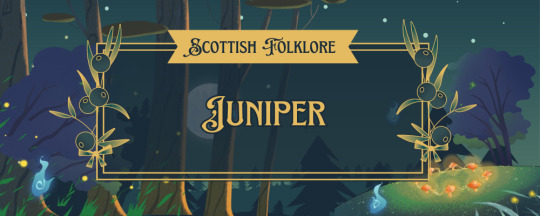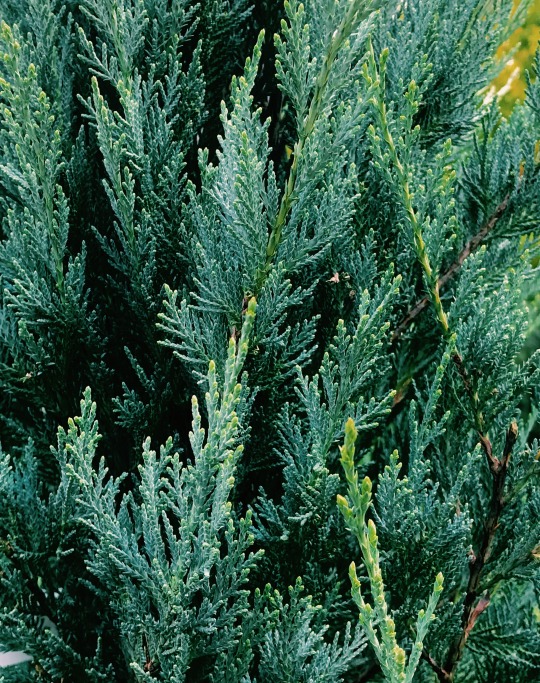#lubhar-beinne
Text
The Scottish Folklore of Using Juniper Smoke to Sain

Within historical Scottish folklore, juniper (also called: mountain yew, Iubhar-beinne, or aiteal) is often mentioned as being protective against supernatural forces, which is why it is one of many ways someone might sain(cleans or protect) people, places, or things. However, when gathering juniper, you weren’t supposed to take a clipping, but instead pull up the whole plant. For obvious environmental reasons, I have to strongly advise against murdering a slow-growing (and endangered) protected plant.
“This plant is a protection by sea and land, and no house in which it is will take fire. It must be pulled by the roots, with its branches made into four bunches, and taken between the five fingers…-“
“The History of Witchcraft in Europe” by Various Authors
You would want to smoke to drift over whatever it is you are trying to sain, so where you burnt them was very important. As well as that, on certain festival days, sains were thought to be more powerful(such as a quarter day), so people would be very likely to partake in juniper saining on those days.
"A fire was kindled in each byre on Christmas morning, and in parts of the country the byres were purified by burning juniper in them."
“Notes on The Folk-Lore of the North-East of Scotland” by Walter Gregor (1881)
Since the cleansing and protective effects were believed to fade, it was often redone several times throughout the year.
While likely not great for people with raspatory problems, smoke does have some science-backed benefits. The oil in juniper is antibacterial and antifungal, while the smoke itself is antibacterial, can help kill/dry out mold, can help keep away insects(including harmful ones, such as ticks, and house-munching ones, such as carpenter ants). This could be part of the reason that smoke finds it’s way into cleansing rituals around the world. Despite these benefits, it is harmful to breathe in any kind of smoke, so please keep that in mind.
One final (but less mentioned) use for juniper was boiling the juniper, and using the water to sprinkle on cattle.
“When a contagious disease enters among cattle, the fire is extinguished in some villages round; then they force fire with a wheel, or by rubbing a piece of dry wood upon another, and there with burn juniper in the stalls of the cattle, that the smoke may purify the air about them; they likewise boil juniper in water, which they sprinkle upon the cattle this done, the fires in the houses are rekindled from the forced fire.”“
Observations on the Popular Antiquities of Great Britain: Chiefly Illustrating the Origin of Our Vulgar and Provincial Customs, Ceremonies, and Superstitions, Volume 1.” by John Brand
#juniper#lubhar-beinne#aiteal#juniper saining#juniper sain#saining#sian#sain#sianing#juniper smoke#scottish folklore#scottish mythology#folklore#scottish witchcraft#Folkmagic
59 notes
·
View notes
Text

Eastern Red Cedar (Essential Herbs for Witches)
*Notes from the Hekate ritual kits that were released October 23'.
Latin name: Juniperus virginiana
Planet: Sun, Saturn
Element: Fire
Parts used: foliage, wood, essential oil
Astrological Association: Leo
Energy: Masculine
Magical properties: Longevity, protection, preservation, strength, wisdom, perseverance, renewal, transformation, balance, connection to the divine through nature, return of stolen goods, defense.
Healing properties: Fever, cough, skin conditions, respiratory issues
Eastern Red Cedar is not actually a true cedar, it’s a juniper, as its latin name, Juniperus virginiana, indicates. Naturalized in Europe, Asia, and North America, Eastern Red Cedar is present in all temperate regions of the northern hemisphere and stretches into parts of the southern hemisphere. This hardy tree has deep roots and tolerates poor rocky soil, salt, heat, and wind, and is drought tolerant.
Medicinally juniper has been used in bathing, sometimes as a scourge, to alleviate rheumatoid arthritis and to relieve depression symptoms and exhaustion. It’s also been used to heal open wounds. Juniper is warming and pungent and affects the liver and kidneys. Its bitter action stimulates the gallbladder and liver and it aids in digestion. Juniper is also used for respiratory issues, urinary tract infections, and skin ailments like psoriasis and eczema. The warming effect of juniper makes it helpful in breaking fevers. Eastern red cedar is an abortifacient and should not be used by pregnant women.
Juniper berries have been used to flavor food, beer, and notably gin, and in Ireland the unripe berries are tinctured with whiskey and used as a general health tonic.
As for juniper’s use in folklore and witchcraft, around the Mediterranean and Aegean seas, it was planted to protect a home from evil spirits and malicious men. It was sometimes built into a new house as a structural beam or to fill cracks between stone to drive away illness and evil spirits. Branches were hung above doors to repel witches.
Because it is an evergreen, it’s also used in fertility rites and the berries are sometimes used as an aphrodisiac.
Shamans in Siberia burned and inhaled the smoke of juniper to induce trance, and because of its high thujone contain, it can indeed induce altered states. Thujone does build in the liver over time so care should be taken to limit smoke inhalation to occasional use.
Burning juniper as a smudge was common in Native American rituals for purification and to cleanse sacred ritual space. Cherokee natives believed that the wood of this cedar held the spirits of their ancestors. In other native ritual practices, it was believed that messages were sent to the Creator when it was burnt ceremonially.
In Scottish folk magic, juniper is used to ‘sain’ livestock and homes during Beltaine and Samhain. Saining is done by lighting bonfires and driving cattle between them. These fires would be lit from sacred Neid fires and extinguished home fires would be relit with this fire. People also hopped over these fires to rid themselves of negative spirits. Juniper (lubhar beinne) was used, and to a lesser extent, mountain ash or rowan (caorran). The cattle byre was sained, and the lintel over the byre was anointed with wine or human urine. Homes were also sained with burning juniper and “in such quantities to fill the whole house with smoke.” Juniper would have also hung at windows to ward off witches and evil spirits and to rid the house of pests and diseases.
According to Scottish folklore, juniper needed to be harvested in a particular way, like all magical plants. It was pulled by the roots, taking 4 branches between 5 fingers while an incantation was repeated. Today we should probably refrain from yanking bushes from the ground and taking a branch or some berries after asking permission should suffice. The branches can be dried and burned or the berries can be burned on a charcoal disc, or dip the branch into sea salted water and sprinkle a bit on yourself and your magical working space.
While we generally think of juniper as a plant of the Sun, it does have older Saturnian associations perhaps because they are very long lived, but maybe also because of their often gnarled wood and spiky foliage, giving them a dark, ominous aspect. Like both yew and cypress trees, Easter red cedar is common in older cemeteries in the southern united states. This may be because its evergreen leaves have come to symbolize ‘eternal life’, but through the ancient Greeks, we have an association with juniper as a plant of Hekate, perhaps because she led the procession of the dead. Through Hekate, it is also associated with Medea, a Hekatean priestess.
I choose to substitute Eastern red cedar for the yews, cypress, and cedar we traditionally see aligned with Hekate because ERC happens to grow in abundance in my bioregion and has a long history of use in sacred rites across the world. Eastern red cedar is a plant of protection and is excellent for banishing, inspiring courage and strength, purification and release.
6 notes
·
View notes